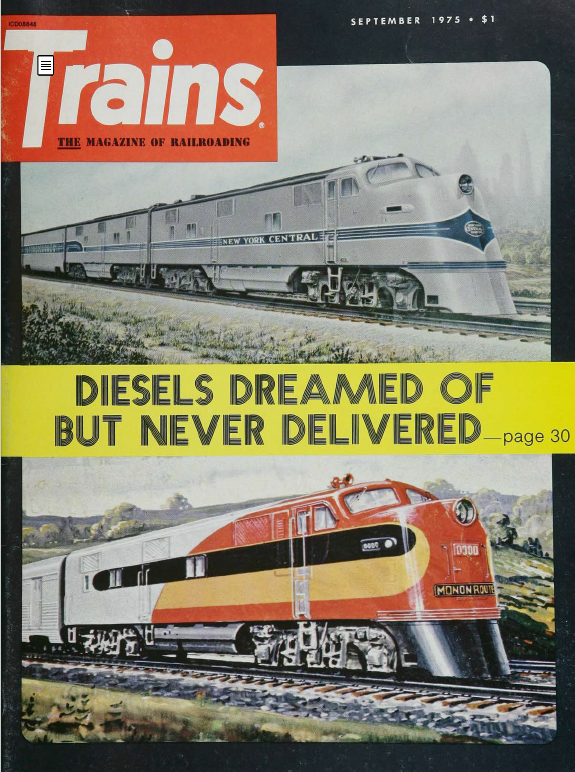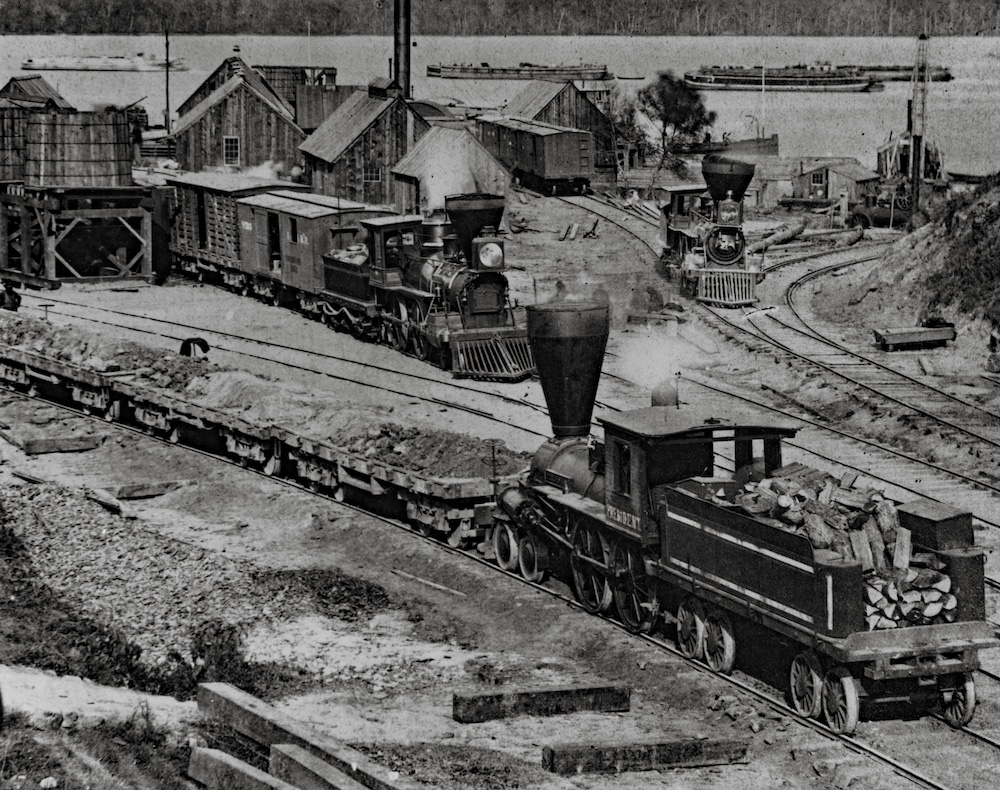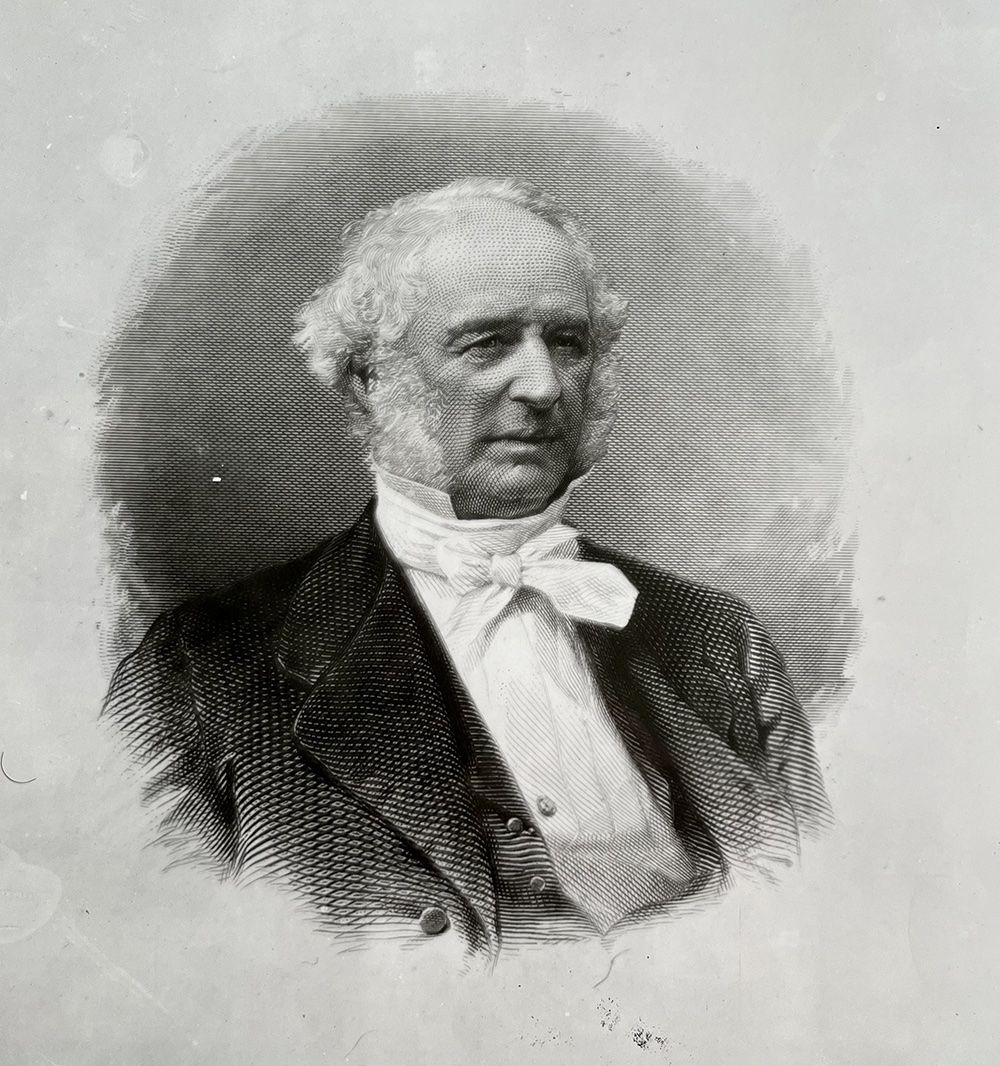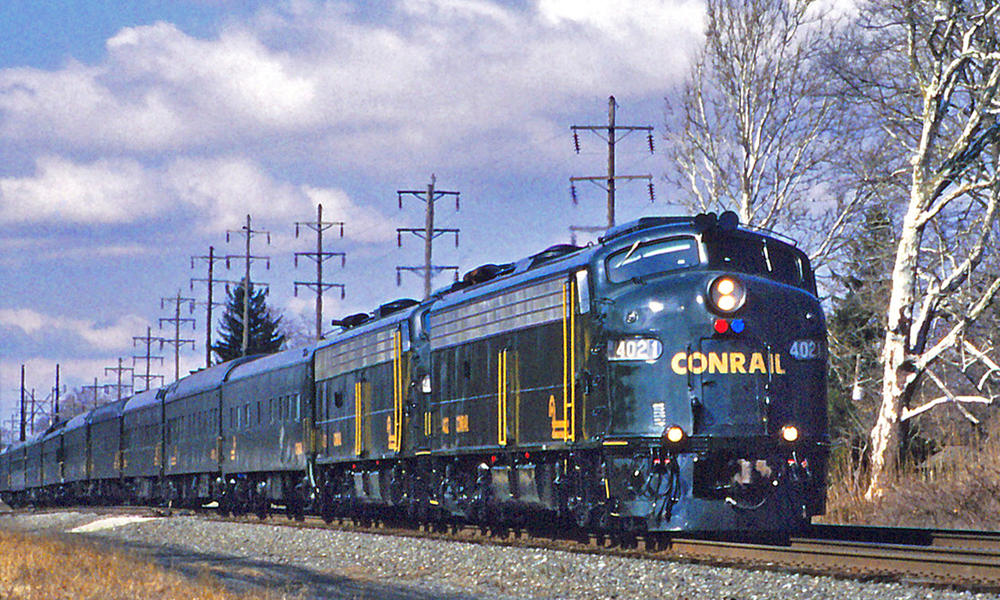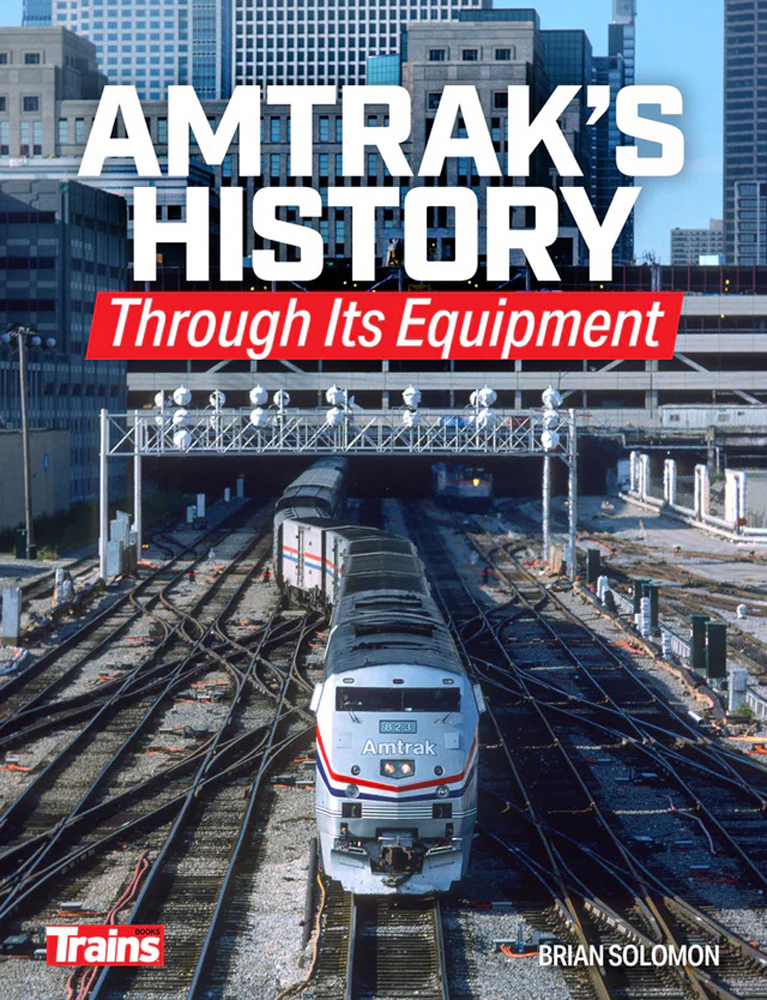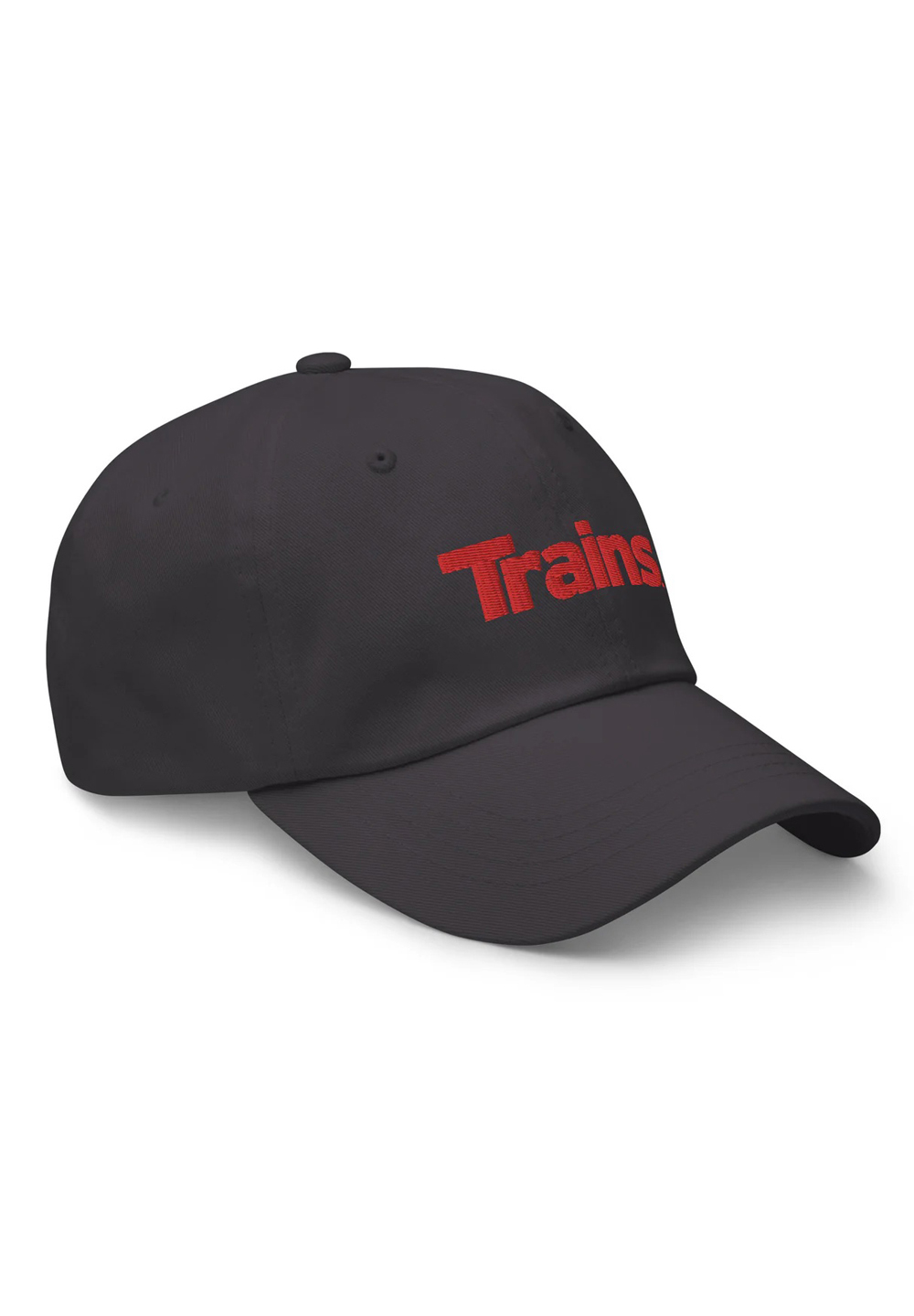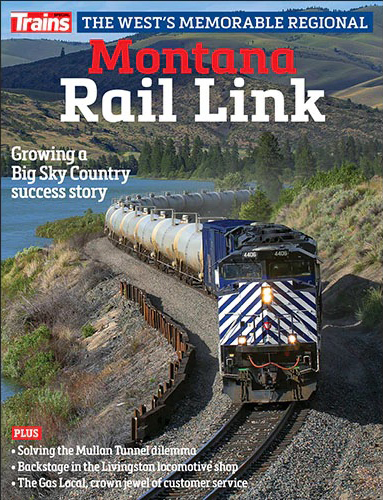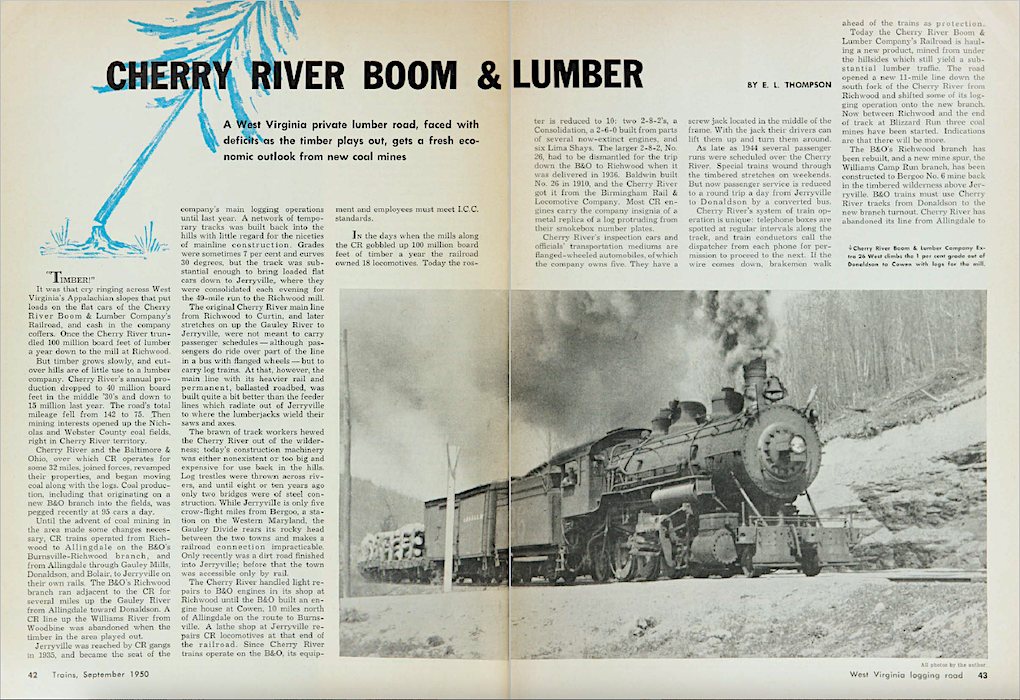
“TlMBER!”
It was that cry ringing across West Virginia’s Appalachian slopes that put loads on the flat cars of the Cherry River Boom & Lumber Company’s Railroad, and cash in the company coffers. Once the Cherry River trundled 100 million board feet of lumber a year down to the mill at Richwood. But timber grows slowly, and cutover hills are of little use to a lumber company. Cherry River’s annual production dropped to 40 million board feet in the middle ’30s and down to 15 million last year. The road’s total mileage fell from 142 to 75. Then mining interests opened up the Nicholas and Webster County coal fields. right in Cherry River territory.
Cherry River and the Baltimore & Ohio, over which CR operates for some 32 miles, joined forces, revamped their properties, and began moving coal along with the logs. Coal production, including that originating on a new B&O branch into the fields, was pegged recently at 95 cars a day. Until the advent of coal mining in the area made some changes necessary. CR trains operated from Richwood to Allingdale on the B&O’s Burnsville-Richwood branch, and from Allingdale through Gauley Mills, Donaldson, and Bolair, to Jerryville on their own rails. The B&O’s Richwood branch ran adjacent to the CR for several miles up the Gauley River from Allingdale toward Donaldson. A CR line up the Williams River from Woodbine was abandoned when the timber in the area played out.
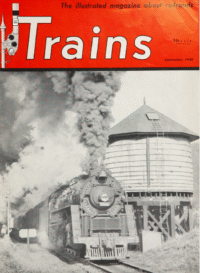
Jerryville was reached by CR gangs in 1935. and became the seat of the company’s main logging operations until last year. A network of temporary tracks was built back into the hills with little regard for the niceties of mainline construction. Grades were sometimes 7 per cent and curves 30 degrees, but the track was substantial enough to bring loaded flat cars down to Jerryville, where they were consolidated each evening for the 49 -mile run to the Richwood mill.
The original Cherry River main line from Richwood to Curtin, and later stretches on up the Gauley River to Jerryville, were not meant to carry passenger schedules although passengers do ride over part of the line in a bus with flanged wheels but to carry log trains. At that, however, the main line with its heavier rail and permanent, ballasted roadbed, was built quite a bit better than the feeder lines which radiate out of Jerryville to where the lumberjacks wield their saws and axes.
The brawn of track workers hewed the Cherry River out of the wilderness; today’s construction machinery was either nonexistent or too big and expensive for use back in the hills. Log trestles were thrown across rivers, and until eight or ten years ago only two bridges were of steel construction. While Jerryville is only five crow-flight miles from Bergoo, a station on the Western Maryland, the Gauley Divide rears its rocky head between the two towns and makes a railroad connection impracticable. Only recently was a dirt road finished into Jerryville; before that the town was accessible only by rail.
The Cherry River handled light repairs to B&O engines in its shop at Richwood until the B&O built an engine house at Cowen. 10 miles north of Allingdale on the route to Bumsville. A lathe shop at Jerryville repairs CR locomotives at that end of the railroad. Since Cherry River trains operate on the B&O, its equipment and employees must meet I.C C. standards.
In the days when the mills along the CR gobbled up 100 million board feet of timber a year the railroad owned 18 locomotives. Today the roster is reduced to 10: two 2-8-2s, a Consolidation, a 2-6-0 built from parts of several now-extinct engines, and six Lima Shays. The larger 2-8-2, No. 26. had to be dismantled for the trip down the B&O to Richwood when it was delivered in 1936. Baldwin built No. 26 in 1910. and the Cherry River got it from the Birmingham Rail & Locomotive Company. Most CR engines carry the company insignia of a metal replica of a log protruding from their smokebox number plates.
Cherry River’s inspection cars and officials’ transportation mediums are flanged-wheeled automobiles, of which the company owns five. They have a screw jack located in the middle of the frame. With the jack their drivers can lift them up and turn them around.
As late as 1944 several passenger runs were scheduled over the Cherry River. Special trains wound through the timbered stretches on weekends. But now passenger service is reduced to a round trip a day from Jerryville to Donaldson by a converted bus.
Cherry River’s system of train operation is unique: telephone boxes are spotted at regular intervals along the track, and train conductors call the dispatcher from each phone for permission to proceed to the next. If the wire comes down, brakemen walk ahead of the trains as protection.
Today the Cherry River Boom & Lumber Company’s Railroad is hauling a new product, mined from under the hillsides which still yield a substantial lumber traffic. The road opened a new 11-mile line down the south fork of the Cherry River from Richwood and shifted some of its lodging operation onto the new branch. Now between Richwood and the end of track at Blizzard Run three coal mines have been started. Indications are that there will be more.
The B&O’s Richwood branch has been rebuilt, and a new mine spur, the Williams Camp Run branch, has been constructed to Bergoo No. 6 mine back in the timbered wilderness above Jerryville. B&O trains must use Cherry River tracks from Donaldson to the new branch turnout. Cherry River has abandoned its line from Allingdale toDonaldson, using the B&O into Cowen and a new cutoff with better grades and curves from Cowen to Donaldson. The rest of the line is resplendent in new 100-pound rail (replacing 60-pound), new treated ties, new steel bridges and new wider curves.
Richwood has added coal mining to its list of industries. Headquarters for some of the Gauley-Sewell mining operations are based there. Mines are located at Bolair, Miller Mill Run, and Turkey Creek on the Donaldson-Jerryville segment, and on a switchback timber line which runs south out of Jerryville.
Once a week it used to be daily 2-8-2 No. 26 leaves Richwood mill at 7 a.m. with about 30 empty flat cars for the loggers to fill; the train pulls into Jerryville about noon. After lunch she rambles back down the main line, drops a string of loaded hoppers at the B&O interchange, and ties up at Richwood by 7 p.m.
While No. 26’s logging trip over the rails of the Cherry River Boom & Lumber Company isn’t made as often as it used to be, other trains haul revenue-producing hoppers from Jerryville to Donaldson, where the B&O picks them up for the trip to the hungry furnace maws of industry. Whether it hauls coal or wood, the Cherry River has been assured a future by productive Mother Nature.
Editor’s Note: Operations on West Virginia’s Cherry River Boom & Lumber Company Railroad, profiled in this 1950 article, ceased when the company shut down in 1960.






